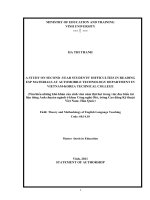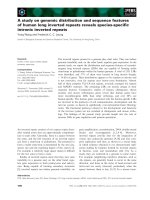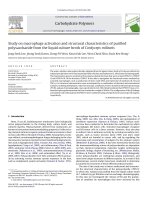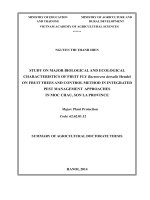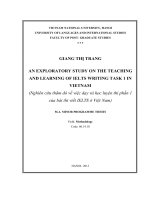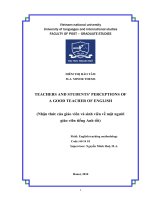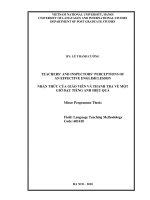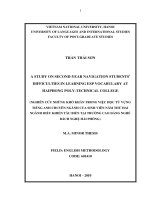An exploratory study on the teachers and students’ perceptions of an ESP course at the infantry officer training college number one
Bạn đang xem bản rút gọn của tài liệu. Xem và tải ngay bản đầy đủ của tài liệu tại đây (1.06 MB, 56 trang )
VIETNAM NATIONAL UNIVERSITY, HA NOI
UNIVERSITY OF LANGUAGES AND INTERNATIONAL STUDIES
FACULTY OF POST-GRADUATE STUDIES
*********************
KIỀU TRÍ DŨNG
AN EXPLORATORY STUDY ON THE TEACHERS AND STUDENTS’
PERCEPTIONS OF AN ESP COURSE AT THE INFANTRY OFFICER
TRAINING COLLEGE NUMBER ONE
(Nghiên cứu thăm do
̀
nhâ
̣
n thư
́
c cu
̉
a gia
́
o viên va
̀
ho
̣
c viên đối vơ
́
i kho
́
a ho
̣
c tiếng
Anh chuyên ngành ở trường Sỹ quan lục quân 1)
M.A. MINOR PROGRAMME THESIS
Field: English Language Teaching Methodology
Code: 60.14.10
Hanoi- 2013
VIETNAM NATIONAL UNIVERSITY, HA NOI
UNIVERSITY OF LANGUAGES AND INTERNATIONAL STUDIES
FACULTY OF POST-GRADUATE STUDIES
*********************
KIỀU TRÍ DŨNG
AN EXPLORATORY STUDY ON THE TEACHERS AND STUDENTS’
PERCEPTIONS OF AN ESP COURSE AT THE INFANTRY OFFICER
TRAINING COLLEGE NUMBER ONE
(Nghiên cứu thăm do
̀
nhâ
̣
n thư
́
c cu
̉
a gia
́
o viên va
̀
ho
̣
c viên đối vơ
́
i kho
́
a ho
̣
c tiếng
Anh chuyên ngành ở trường Sỹ quan lục quân 1)
M.A. MINOR PROGRAMME THESIS
Field: English Language Teaching Methodology
Code: 60.14.10
Supervisor: PhD. Dương Thi
̣
Nu
̣
Hanoi - 2013
i
CERTIFICATE OF ORIGINALITY
I certify my authorship of the minor thesis submitted entitled:
AN EXPLORATORY STUDY ON THE TEACHERS AND STUDENTS’
PERCEPTIONS OF AN ESP COURSE AT THE INFANTRY OFFICER
TRAINING COLLEGE NUMBER ONE
In terms of the statement of requirements for the thesis and the field study
reports in Masters’ programs is the result of my own work, and that this minor
thesis or any part of the same had not been submitted for a higher degree to any
other universities or institutions.
Kieu Tri Dung
ii
ACKNOWLEDGEMENTS
I am grateful to many people who have supported me and encouraged me
all the time. Without their assistance, I could not have accomplished my thesis.
First of all, I would like to express my sincere appreciation to my thesis
supervisor, Dr. Duong Thi Nu. During the journey of working my thesis, she
never hesitated to make profound comments and provided me a lot of
suggestions and insightful advice. It is impossible for me to complete this thesis
without her support and assistance. I would like to show my deepest gratitude to
her.
My special thanks also go to all my teachers of the Post-graduate course
20 at Vietnam National University, Hanoi, University of Languages and
International Studies, for their interesting and useful lectures.
Moreover, I greatly appreciate the members of the Department of Foreign
Languages at the Infantry Officer Training College Number One, for their
contribution to the data collection and their constructive suggestions for this
research.
Additionally, I am truly grateful to both the teacher-participants and
student-participants. It is impossible to complete my research without their
participation.
Finally, I would like to extend my thanks to my beloved family for their
love and unhesitating supports.
iii
ABSTRACT
This study was designed to investigate the teachers and students’
perceptions of an ESP course at the Infantry Officer Training College Number
One (IOTC No.1). The investigation aims to explore: (1) The students’
perceptions of their English ability, difficulties, and expectations toward ESP;
(2) the teachers’ opinions and perceptions of ESP courses and their expectations
of future ESP pedagogy.
The participants involved in this study were 165 non-English major
military students who had taken ESP course for a semester and 05 instructors
who were ESP teachers in the Infantry Officer Training College Number One.
The major findings of the present study were summarized as follows:
First, the students perceived that their English language competence was
inadequate, they were aware of the importance and the difficulties as well as
their future needs toward ESP courses. Second, several potential issues arose
concerning with ESP, such as instruction time, content of ESP, and ESP
teachers’ qualification. Last, the results of this study suggested that a
collaborative teaching could be an alternative of present ESP instruction to
partially solve the problems.
Finally, pedagogical implications and suggestions for future research were
provided in the last part of the study.
iv
LIST OF TABLES AND CHARTS
Table 1: Demographic data of the student-participants
Table 2: Demographic data of the teacher-participants
Table 3: Distribution of the teacher-participants of interview questions
Table 4: Distribution of frequency of student questionnaire- Section B
Table 5: Distribution of frequency of student questionnaire- Section C
Table 6: Distribution of frequency of student questionnaire- Section D
Table 7: Distribution of frequency of student questionnaire- Section E
Chart 1: The rating of the students' answers to the questions- Section B
Chart 2: The rating of the students' answers to the questions- Section C
Chart 3: The rating of the students' answers to the questions- Section D
Chart 4: The rating of the students' answers to the questions- Section E
ABBREVIATIONS
AUB: American University of Beirut
EAP: English for Academic Purposes
EFL: English as a Foreign Language
EGP: English for General Purposes
ESL: English as a Second Language
ESP: English for specific purposes
GE: General English
IOTC No.1: The Infantry Officer Training College Number One
M.A: Master of Arts
NA: Needs analysis
NATO: North Atlantic Treaty Organization
SOP: Standard Operating Procedure
TESOL: Teaching English for Speakers of Other Language
v
TABLE OF CONTENTS
Certificate of originality …………………………………… i
Acknowledgements………………………………………………….…… ii
Abstract……………… ………………………………………………… iii
List of tables, charts and abbreviations ………….…………… … ………… …iv
Table of contents…………………………………………… v
PART A:
INTRODUCTION I
1. Background to the study…………… ………………………………….1
2. Aims of the study……………….…………………………………… 2
3. Research questions………… ………………… …………………… 2
4. Scope of the study…………………………….………………… 3
5. Significance of the study……………………………… ………… 3
6. Organization of the study……………………… …………… 3
PART B: DEVELOPMENT……………….……………………………… II
CHAPTER ONE: LITERATURE REVIEW
I.1. English for specific purposes and military English…………….…… 4
I.2. Needs analysis in ESP……………………… …………………… 7
I.3. Materials and curriculum in ESP…………………….……………… … 9
I.4. Problems and challenges of ESP…………………….……………… ….10
I.4.1. Students’ competence and difficulties toward ESP……… 10
I.4.2.The qualification of ESP teachers…………… 11
I.5. Perceptions and expectations toward ESP……………… 12
CHAPTER TWO: METHODOLOGY
II.1.The teaching context……………………………………………….… 14
II.1.1.The English teaching and learning situation at IOTC No.1…… 14
II.1.2.The teaching staff of the Department of Foreign Languages at IOTC
No.1………………………………………………………………… 14
II.1.3.The students of IOTC No.1…………………………… 15
II.1.4.The ESP materials of IOTC No.1……………………… 16
II.2. Methodology………………….………………………………… 16
II.2.1. Participants……………………………… …………… 16
II.2.2. Methods of the study………………………………………… 17
II.2.3. Instruments of the study…………………………………………… 18
II.2.4. Procedures of the study……………………………….…………… 19
II.2.5. Data analysis……………………….…………………… 19
CHAPTER THREE: DATA ANALYSIS AND FINDINGS
vi
III.1.Analysis of research question 1: What are student perceptions of their
English ability, difficulties, and expectations toward ESP? 20
III.1.1. Students’ self- evaluation of English competence… 20
III.1.2. Students’ opinions about current ESP course……………………… 23
III.1.3. Students’ expectations toward future ESP course… 25
III.1.4. Students’ English activities involved in ESP class……………………27
III.2. Analysis of research question 2: What are the teachers’ opinions and
perceptions of ESP courses and their expectations of future ESP
pedagogy? 29
III.2.1.The correlations between general English competence and ESP
learning 29
III.2.2.The skill was involved in the most in ESP class, the skill the students
need improvement in the most, and the most important skill in ESP
learning 30
III.2.3.The opinions, strengths and weaknesses of current ESP
courses 30
III.2.4.The situations encountered in ESP instruction… ………………… 31
III.2.5.The prerequisites for an ESP teacher from a teacher’s
perspective 31
III.2.6.The expectations and suggestions for prospective ESP courses according
to a teacher’s professional background 31
III.3. Summary ……… ……………………………………………… 32
PART C: CONCLUSION……………………………………………………… III
I. Recapitulation ……….………………………………………………… 33
II. Pedagogical implications….………………………………… ……… 34
III. Limitations of the study and suggestions for further study… ….… 35
REFERENCES… …………………………………………………………… 37
APPENDICES
Appendix A: Questionnaire for the students (Vietnamese)
Appendix B: Questionnaire for the students (English version)
Appendix C: interview questions for the teachers
1
PART A: INTRODUCTION
1. Rationale
English has gradually achieved its significant identity as the world
language during the globalization process. Why English? According to
Hutchinson and Waters (1987), the United States achieved its role of the most
significant political/economic power in the world after World War Two, thus its
language became commonly perceived as a language of opportunity and
empowerment. Crystal (2003) presented several factors to explain the world
status of English today: (a) English is the only or one of the official languages of
many important international organizations, such as the United Nations, the
Organization of Petroleum Exporting Countries and the European Free Trade
Association; (b) a quarter of the world’s periodicals and most academic journals
with an international readership are published in English, and more than 90
percent of international organizations carry on their proceedings entirely in
English; (c) English has been taught as a foreign or second language in over 100
countries. He further pointed out that approximately one in four of the world’s
populations are now already fluent or capable of communicating to a useful
level in English, and the figure is steadily growing.
The ESP programs exploded in Vietnam in the past few years as an
increasing number of adult students were eager to learn ESP or academic
English in order to pursue their careers or study in English-medium educational
institutions. To be fluent in a world language like English has become a pressing
matter for individuals to survive in the globally competitive job market. This has
resulted in employers and educational institutions all over the world searching
for ESL/EFL instructors with solid ESP backgrounds (Johns & Price-Machado,
2001).
As the “new knowledge economy” (Dovey, 2006) has arisen, problems
and issues of transferability from academic to professional contexts have
emerged. Dovey pointed out that when “new vocationalism” arises out of a
change in the world’s work contexts, it will in turn lead to a change in the
orientations of higher education in certain contexts. Those universities which
perceive themselves as vocational, and believe themselves to be providing an
education for the real world will be affected the most. Most authorities and
institutions are aware that well-organized ESP curricula can prepare students for
the encounter with globally competitive world. That is, English courses should
be designed to meet learners’ needs in a specific context. However, ESP
practitioners have found that there are underlying problems which make ESP
courses problematic and inefficient.
2
Some ESP teachers impute the inefficiency of ESP courses to the poor
quality of student language skills. Although low student proficiency levels may
lead to poor ESP course outcomes, negative teacher attitudes toward ESP
courses (Braine, 2001), lack of ESP training (England, 2006), inappropriate
instructions and poorly designed syllabi (Braine, 2001), and student ignorance or
inability to foresee their needs and rights regarding ESP are potential problems
(Kavaliauskiene, 2003). In the view of these issues, this study investigate the
teachers’ and students’ perceptions of their ESP course, explores student needs
and expectations of an ESP course at the Infantry Officer Training College
Number One (IOTC No.1).
The findings of the study may provide ESP practitioners and institutional
authorities with a clearer view of existing ESP courses, enabling them to rethink
the objectives of current ESP curricula. Similarly, it may also help students to
build up their awareness of goals, needs, and responsibilities through ESP
learning. Suggestions for a prospective ESP teaching and curriculum for the
students of specific contexts are provided based on the results of the study.
2. Aims of the study
English language skills are required in most specific contexts worldwide.
Consistent with the aims of ESP education in IOTC No.1, ESP courses should
be designed to equip students with adequate English ability to meet their needs.
It is necessary to understand the expectations of teachers and students, as well as
student needs and difficulties, before applying ESP courses. The present study is
designed to investigate IOTC No.1 teachers’ and students’ perceptions of their
ESP course with the following purposes: (1) To understand their perceptions of
the importance of ESP course, to explore student expectations toward ESP
course; (2) to understand student needs and difficulties.
3. Research questions
Based on the purposes of the study, two major research questions are addressed
as follows:
1. What are the students’ perceptions of their English ability, difficulties,
and expectations toward ESP?
2. What are the teachers’ opinions and perceptions of ESP courses and
their expectations of future ESP pedagogy?
4. Scope of the study
The study is focused on the teachers and students’ perceptions of ESP
teaching and learning at IOTC No.1, and the participants were ESP teachers and
the second year students who have learned ESP for one semester at IOTC No.1.
3
The subjects of the study were chosen at random and various among 330 second
year students of IOTC No.1. Yet, the study results cannot be true to all
Vietnamese learners. Thus, my suggestions for ESP teaching and learning
difficulties might work well only for IOTC No.1teachers and for the ones who
are teaching at such colleges with similar English syllabus or education training
or for the ones who concern.
5. Significance of the study
Previous studies (Bacha & Bahous, 2008; Braine, 2001; England, 2006;
Jasso-Aguilar, 1999; Kavaliauskiene, 2003; Shi, Corcos, & Storey, 2001; West,
1994) indicated that potential problems affect the effectiveness of ESP courses.
The significance of the present study, therefore, lies for its exploration of the
students’ perceptions of their ESP learning, the teachers’ perceptions of ESP
teaching. The findings of the present study provide pedagogical implications and
suggestions for prospective ESP teaching and curriculum application at IOTC
No.1. It also provides a closer look at student problems, needs, and expectations.
The researcher hopes that the methods and findings of this study can make a
contribution to ESP teaching and learning.
6. Organization of the study
This thesis is structured into three parts: Introduction, Development, and
Conclusions. Part A presents the introduction and background to the study, the
purposes of the study, the scope of the study, and its significances and
limitations. Part B consists of three chapters. Chapter one presents relevant
literature in the areas of ESP teaching and learning, issues and problems
involved in ESP, ESP materials and curriculum design, as well as the
perceptions of both the teachers and students were reviewed. Chapter two
provides the teaching context; the research methods, the instruments of data
collection, and the data analysis. Chapter three reports the findings of the
qualitative and quantitative data analysis based on the questionnaires of the
student-participants and interview questions of the teacher-participants, then
gives the recapitulation. Part C gives conclusion, and offers suggestions for
pedagogical applications and further research.
4
PART B: DEVELOPMENT
CHAPTER ONE: LITERATURE REVIEW
The purpose of this chapter is to review the literature relating to the
research issues, in order to provide input into the construction of the framework
for the present study. The background of ESP and the previous studies related to
ESP are addressed in the first section, which includes the development of ESP,
the definitions of ESP, and the characteristics of ESP and military English. The
following section covers Needs Analysis in ESP. Materials and curriculum in
ESP are addressed in the third section, while the fourth section talks about the
problems and challenges involved in ESP, including student English competence
and difficulties with ESP, and the qualifications of ESP teachers. In the final
section, learner and teacher perceptions of ESP courses, and research related to
the perceptions of ESP courses is presented.
I.1. English for Specific Purposes and military English
After the Second World War scientific, technical and economic activity
increased tremendously worldwide. As the United States played the key role in
the post-war economy, the English language became the accepted international
language of technology, science and commerce. The situation, in its own turn,
created the need for learning English and this time the learners knew exactly
what they needed and why they needed it (Hutchinson and Waters 2001: 6).
ESP, as an area of teaching English as a foreign language, emerged in the
late 1960s (Ibid. 5). In the case of teaching ESP the stress is rather on the
language in context than learning grammar or language structures. Another
important point is that ESP learners learn the language that is really important
and necessary for them.
Nowadays ESP has an important part in learning and teaching the English
language and it has undergone many changes. When traditionally the aim of
linguistics has been to describe the rules of English usage and grammar then the
new idea of ESP is to analyze the linguistic characteristics of learners’ specialist
areas of work or study and to determine the specific needs of learners (Ibid. 8).
Hutchinson and Waters (Ibid.8) point out that “learners were seen to have
different needs and interests, which would have an important influence on their
motivation to learn and therefore on the effectiveness of learning.” It was also
understood that particular groups of learners use language, which have different
specific linguistic characteristics.
Military English has also some specific characteristics. One of the
characteristics is that the military use the imperative to issue orders, commands
and instructions. Imperatives are used when a position of authority is involved
5
as is the case in the military. Polite forms such as “Would you”, “Could you”
are not commonly used. Instead “You are to” is the form to issue orders. For
example, instead of a polite response to a knock on the door and the reply to the
knocking “Will you, please, come in!” A military person would say “Come in!”
Another characteristic is that the passive voice is avoided in many cases
as it usually shows that the person who performs some action is not important or
that one wishes to avoid responsibility. In the military there is always someone
who has to take responsibility for actions, and that is why the military prefer the
active voice instead of the passive. For example, instead of writing in a report
that “The safety instructions were not followed (by Cpl Smith) it would be Cpl
Smith did not follow the safety instructions.” Nonetheless, the students need to
know the passive voice as well in order to pass the examinations after the
courses.
In terms of military documents, everything must be direct and laconic.
There are no long descriptions; instead simple tenses and short sentences are
used. Everything should be short, simple, and to the point. On the other hand,
when the military give an oral description of something, such as a situation or a
picture as a task in the lesson, the descriptions are full of detail, and the students
like to add their own experience to the descriptions. For example, describing two
soldiers talking to each other, the students start with the description of the
background and the soldiers. And then, based on their experience, they explain
why they are carrying exactly this type of weapon and, what can be done with
the weapon, etc. The higher the level of language command, the more detailed
the descriptions are.
Military English can also be characterized by the abundant use of
abbreviations, acronyms and military slang. The use of abbreviations and
acronyms is mandatory rather than recommended. For example, Standard
Operating Procedure C01 (SOP C01 Application of New Standard) from the
U.S. Army Civilian Personnel Management department contains 873 words, 100
of which are either acronyms or abbreviations (26 different acronyms and
abbreviations repeated 100 times in the document).
Another characteristic feature of military English is the NATO phonetic
alphabet. It is mainly used during radio transmissions to ensure the clarity of the
message and to avoid misunderstandings when it comes to similar-sounding
words. Also, it is used instead of the civilian spelling alphabet in the case of
difficult words. The NATO alphabet is not only used by the military but also by
the civilians when two nations need to cooperate and communicate with each
other (e.g. airline pilots).
6
Telling time is also different in the military context. The military, but also
aviation, meteorology, astronomy, emergency services, hospitals, etc. use the
24-hour clock to avoid ambiguity of the 12-hour system. For example, “3:00
am” is “0300 hours” and is pronounced oh three hundred hours or zero three
hundred hours; and “3:00 pm” is “1500 hours”, pronounced fifteen hundred
hours. Written military time does not separate hours and minutes, that is, 1430
vs. regular time 14:30. Also the leading zeros are pronounced every time (0100
is pronounced oh one hundred hours or zero one hundred hours). Hours is added
at the end, even if it is not written (1800 is pronounced eighteen hundred hours).
Military jargon is also an important aspect of military language. Rich of
military acronyms, abbreviations, secret meanings and obscure nuances, military
jargon can confuse someone who is unfamiliar with it (Scasny 2004). Different
military branches may use different military jargon, which can, in its turn, cause
ambiguities.
One of the differences between GE and ESP, according to Hutchinson and
Waters (2001:16), is that GE is usually studied for exam purposes whereas ESP
for work, study or training. It does not imply that in specific situations we need
to study only ESP. “Though the content of learning may vary there is no reason
to suppose that the process of learning should be any different for the ESP
learner than for the General English learner.” (Ibid. 18)
Hutchinson and Waters (Ibid. 9) suggest that ESP must be seen as an
approach rather than a product and that the foundation of all ESP is one simple
question-why does this learner need to learn a foreign language? For the
military, the answer is simple-without the knowledge of English they cannot
take part in international training exercises and military missions and without
the experience of international cooperation they cannot make a career.
Dudley-Evans and St John (2001: 10) conclude that the teaching of GE is
less motivating for the learners than ESP. The teaching experience at the IOTC
no.1 shows that when military English topics are discussed in the lessons, the
students become lively and very interested, and it is clearly seen that the level of
motivation is different from discussing GE topics.
In the case of ESP, to be more precise, specific ESP, the language teacher
is often not an expert of the subject matter. In many cases the students know
more about the content than the teachers and this provides the opportunity “… to
draw on students’ knowledge of the content in order to generate genuine
communication in the classroom.” (Dudley-Evans and St John 2001:13). As
military English comprises many different areas (e.g. artillery, engineering,
communications, etc.), it is almost impossible to find a person who would be
7
able to teach English and at the same time be an expert in these areas. Thus,
quite often there is cooperation in the lessons- the teacher helps the students
with the English language and the students help the teacher with specific
terminology or understanding the subject matter.
Dudley-Evans and St John give a true and comprehensive description of
ESP teachers as follows:
ESP teachers also need to have a great deal of flexibility, be willing to
listen to learners, and to take an interest in the disciplines or professional
activities the students are involved in. They must be ready to change tack
in a lesson to take account of what comes up, and to think and respond
rapidly to events. ESP teachers must also be happy to take some risks in
their teaching. The willingness to be flexible and to take risks is one of the
keys to success in ESP teaching. (Dudley-Evans and St John 2001:14)
I.2. Needs Analysis in ESP
Needs refer to necessities, lacks or wants (West, 1994). Brindley (1984)
defined needs as students’ study or job requirements. Robinson (1991) further
illustrated needs as linguistic deficiency. They are goal-oriented and can be
regarded as “objective”.
Needs Analysis (NA) is a defining feature of ESP. NA is a necessary step
in designing ESP syllabus, tasks and materials (Belcher, 2006; Flowerdew &
Peacock, 2001). It is seen as a starting point for identifying goals, and
communicative and linguistic needs for students in the language courses (Ferris,
1998). It therefore should be applied before implementing English courses to
ensure an effective English learning experience.
Needs analysis is significant as it is a fundamental basis of the ESP
course design. Basturkmen (2006) argued that a key feature of ESP course
design is that the syllabus should be based on an analysis of the learners’ needs.
Without the consideration of learner needs, the teachers, curriculum developers,
and materials designers often tend to perceive the future needs of the students
using their intuitions, which may lead to a limited success in the subsequent ESP
course (Braine,2001; John, 1991). Thus, ESP course designers should engage in
analyzing learner needs before designing courses, and to fulfill those needs
within the context of the relevant ESP course.
Shaaban (2005) conducted a needs analysis survey to help program
administrators identify the objective communicative needs and expectations of
the employees in the personnel office at the American University of Beirut
(AUB).One hundred twenty-two participants consisting of university employees
including janitors, gardeners, security guards, library staff, and comptroller’s
8
office staff, were chosen to participate in a 10-week ESP program. The English
course for AUB employees was developed to address the identified needs and
expectations. The content analysis of responses showed that the teachers highly
valued the experience and were satisfied with the course design, student
attitudes, student performance, and instructional materials.
An ESP course can be tailor-made to meet the specific needs of learners
by appropriate analysis. Shi, Corcos, and Storey (2001) investigated six sessions
of clinical ward instruction. They identified the linguistic skills the students
needed in order to achieve various learning objectives, such as using appropriate
terms to translate information form doctor-patient to doctor-doctor discourse,
using verb tenses correctly to establish chronology in case reports, and
describing location and procedure accurately in reporting physical examinations.
The study reported that the authentic data can be employed to construct a tightly
focused curriculum addressing students’ needs of the ward session. The data
derived from the needs analysis helped ensure a practical and useful instruction.
Edwards (2000) conducted a case study in a specialized context, a bank,
which involved three German bank officers (one man and two women). The
researcher conducted a prior needs analysis on the first day of the course. The
overall objective of the course was to improve the speaking confidence of
female students in a native-speaking setting. It concluded that the learners gave
positive feedback on this course and asserted that they learned how to use
English speaking in specific meeting or negotiating situations. It also suggested
that current authentic texts could be used selectively and efficiently when
adapted to the specific needs of particular learners in ESP context.
However, obstacles to needs analysis exist.ESP programs vary in length
of time and in focus, in class size, in language level, and in goals and objectives.
Therefore, teachers may not have easy access to gain information about student
proficiency levels beforehand, and learning goals may not be individually
specified. In some cases, the curriculum and materials might have been prepared
by administrators or sponsors before the key information is obtained. Even when
the results of the NA are obtained; they may not be acceptable to the sponsoring
institutions in terms of careful timing and administering of directions (Yogman
& Kaylani, 1996).
Furthermore, ESP teachers are unwilling or unable to conduct the
necessary analysis when faced with some specialist texts that require more time
and energy in the practical teaching context. This inevitably fails to prepare
learners to meet their requirements academically or vocationally (Crosling &
Ward, 2002; Ferris, 1998, Jasso-Aguilar, 1999). Crosling and Ward (2002)
9
examined the workplace needs of oral communication and language use of
business employees who graduated from Monarch University, Australia. They
found that the oral communication training failed to prepare the business
undergraduates to meet their needs in the work context. That failure may be due
to the oral communication curricula not being developed based on student needs.
They suggested that a prior analyzing is necessary before the language class.
I.3. Materials and curriculum in ESP
ESP instruction is learner-centered and curriculum development is goal-
oriented. ESP course should be tailored to the specific learning and language use
needs of identified groups of learners, yet, must also be sensitive to the socio-
cultural contexts in which these learners will use English for specific purposes
(Johns and Price-Machard, 2001). Once the goals have identified by prior
analysis and the syllabus of ESP has been established based on the language
needs of the learners, the teaching materials should be developed or selected.
The key concept in developing or selecting teaching materials for ESP is
authenticity. The tasks and materials which are presented in the learning
situations should be authentic (Robinson, 1991). It is hard for many ESP
teachers to make a choice between published materials and materials tailored
specifically to the targeted situations.
This is a wide range of course types in ESP, and the timetables may vary
from one to another. It is impossible for a ready-made material or a book to be
useful across a wide range of ESP courses. Even when suitable materials are
available, exchange rates or import restrictions may remove them from
consideration (Hutchinson & Waters, 1987). One solution is for ESP teachers to
produce the in-house materials to fulfill the needs of particular learners in the
specific subject area. It could be both time-consuming and exhausting, but
producing materials may help to make teachers themselves more aware of what
is involved in teaching and learning.
Troy, Chrimes (2002) explored the role of homegrown ESP materials in
meeting the immediate academic reading demands that EFL engineering majors
face in their major courses. They concluded that the homegrown materials can
supplement the students’ major courses. Further, they found that in-house
material developers can present authentic materials which are highly focused on
the learners’ particular needs.
However, producing of teaching materials is time-consuming, and few
ESP teachers are trained in the skills and techniques of material production
(Hutchinson & Waters, 1987). In addition, in-house materials produced by the
ESP teacher alone may not be able to ensure teaching quality. Collaboration
10
with subject teachers can remedy the weakness, and teachers can complement
each others’ expertise (Salsbury, 2005). Further, ESP instructors’ expertise
affects the materials selection, teaching practice, and teaching techniques.
No matter what kind of material is chosen, one thing that should be born
in mind is that the contents of ESP should be authentic, and specific to the goals
and needs of particular learners.
I.4. Problems and challenges of ESP
ESP is usually designed to fulfill the diverse needs of learners in specific
contexts. It is more problematic and complicated than its counterpart, EGP. The
ESP courses vary in goals, contents, methodologies, and instructional
approaches. There are thus a huge variety of issues and problems in ESP
courses. Previous studies have investigated the problems and challenges
involved in ESP classes, including students’ inadequate English language skills
(Basturkmen, 1998), learning difficulty toward ESP (Ferris & Tagg, 1996 a/b),
insufficient instruction hours (Strevens, 1980), large class size and low
motivated learners (Braine, 2001; Strevens, 1980), and teacher qualifications
(Hutchinson & Waters, 1987, Dulley- Evans & St John, 2001). All of them were
regarded as negative factors that affected the effectiveness of ESP.
I.4.1. Students’ competence and difficulties in ESP
ESP is designed to meet the specific needs of learners. Learners are
expected to perform with adequate language skills in target situations at the end
of the ESP courses. However, the performances of ESP learners have been
considered unacceptable or poor in many cases (Bacha & Bahous, 2008; Jasso-
Aguilar, 1999). Students’ overall English language competence has usually been
considered the indicator of the success or failure of English learning (Shi,
Corcos, & Storey, 2001). Some teachers imputed the low achievement of ESP to
the students’ poor English language skills. They argued that the students’
English language skills were inadequate to cope with the ESP courses, and made
ESP courses inefficient.
By contrast, the students often declare themselves to be suffering from
learning difficulties, which makes them perform badly in ESP class. Some
researchers also reported that students suffer from learning difficulties relating
to the content of ESP (Gatehouse, 2001), the instruction of ESP (Bacha &
Bahous, 2008; Leki& Carson, 1994), and the tasks involved in the ESP courses
(Ferris & Tagg, 1996 a/b). The students had difficulties participating in class
discussion, asking and responding to questions, and general listening
comprehension. Learners have difficulty coping with the ESP courses because
of weak English skills (Jacksons, 2004).
11
The content of ESP is also regarded as one of the factors affecting the
ESP learning. The difficulty level of the content should be accessible and
acceptable to learners, as most learners lack general English skills (Basturkmen,
1998; Jackson, 2004). Further, the activities in the ESP class should be applied
based on the learning goals and should be meaningful in relation to the specific
purpose of their target subject area (Flowerdew& Peacock, 2001).
I.4.2.The qualification of ESP teachers
The capability of the ESP teachers has often been considered one of the
factors affecting the effectiveness of ESP. Without well-prepared teachers, ESP
classes are often low in quality and ineffective (England, 2006). Qualified ESP
teachers are required to be professional in English language teaching and to have
a higher level of subject knowledge.
Further, ESP teachers often have to carry out other roles than that of an
English teacher. Hutchinson and Waters (1987) pointed out that, in addition to
be a normal function of a teacher, the ESP teacher will have to deal with the
prior analysis of learner needs, syllabus design, materials provision, and
evaluation. In some EAP situations, teachers must be able to co-operate with
subject teachers (Flowerdew & Peacock, 2001). As a result, a great workload is
imposed on ESP teachers.
ESP teachers are expected to play five key roles (Dudley-Evans & St
John, 2001): teacher, course designer, and materials provider, collaborator,
researcher, and evaluator. To carry out the above roles, ESP teachers should be
trained in language teaching competence and subject-specific knowledge.
However, there are no certain answers to how well an ESP teacher should
be. Prepared and trained, or how much subject knowledge the ESP teacher
should be required to master. Looking at the level of ESP teachers’ subject
knowledge, Hutchinson and Waters (1987) required just three things:
1. A positive attitude toward the ESP content.
2. Knowledge of the fundamental principles of the subject area.
3. Awareness of how much they probably already know.
In other words, the ESP teachers should be willing to: (1) adjust teaching
activities and materials to student needs,(2) be familiar to some extent with the
students’ specialized area,(3) be interested in and (4) acquire knowledge of the
students’ specialized area. Furthermore, they have to foster independent study
habits among the students, but do not need to become a teacher of subject
matter. However, ESP teaching is different from EGP teaching. The great
majority of ESP teachers have not been well-trained. Thus, they need to
orientate themselves to the new teaching environment.
12
There are not ready-made or straightforward answers to the problems that
ESP teachers may expect to encounter. The ESP teachers should always stay
open- minded and flexible. Hutchinson and Waters (1987) indicated that “All
ESP teachers are an effect pioneers who are helping to shape the world of ESP”
(p.160).
The goal of ESP learners is to learn English for the purpose of carrying
out certain roles in a specific context, such as studying in an English-medium
institution. They are also required to develop the skills of studying alone outside
the classroom and promoting independent study habits. Thus, if the teachers
neglect to foster student ability to be independent, they are considered to have
failure.
I.5. Perceptions and expectations toward ESP
ESP is designed based on the learners’ needs and wishes. Through needs
analysis, learners perceive their needs and express their expectations of ESP
class, while ESP practitioners perceive learner needs and expectations, and
develop authentic materials to fulfill the specific needs of learners in particular
contexts. Student perceptions of the requirements and needs of their target
situations strongly influence their receptiveness to ESP learning.
Student needs are perceived by teachers based on their expertise in either
their knowledge of English and subject areas, or their working experience in the
real world.
However, there are always gaps produced between teacher and the student
perceptions, or between the instructions and the requirements as they actually
happen in the real classroom context. Therefore, courses as they are finally
devised may be different from the analyses and be regarded as inauthentic.
Furthermore, learner perceptions of their own needs may be ill-found, inaccurate
or incomplete (West, 1994). This may occur because learners are too young to
be insightful about what they need, or they are not aware the factors affecting
the ESP teaching and learning.
Bacha and Bahous (2008) indicate that faculty and students did not hold
similar views of student English abilities or needs. Ferris (1998) explored 768
ESL students’ perceptions of the language skill requirements in their subject-
matter courses, their difficulties in meeting their expectations, and the
importance of specific language skills and tasks in academic setting. Further, the
similarities and differences in light of the perceptions between instructors and
ESL students were observed. Their findings show that there was considerable
variation in student responses regarding the difficulties they encountered and the
importance of specific language tasks and skills across students’ majors, class
13
levels, status, mother tongues, and gender. In addition, student responses were
dramatically different from those of instructors in ranking specific language
skills.
One explanation for the variation between teachers and students may be
the differing requirements across different class levels and class types which
make the students perceive their needs and expectations differently from their
teachers.
Further, students may have their own views and their own preferences for
language skills and classroom activities where the teachers may have different
opinions. Basturkmen (1998) reports that students with engineering specialties
perceived their speaking to be inadequate, and identified listening as the most
important language skill. On the other hand, the teachers considered reading and
listening as almost equally important in that many reading activities were
involved in engineering classes. However, the students did not always hold
views that were the opposite of their teachers’.
The results presented above explained that student perceptions of the
significance of ESP vary from person to person in light of their specialized
development and individual needs. Further, it shows that such variation is
probable inevitable given the differing needs and pressures on students and
teachers.
14
CHAPTER 2: METHODOLOGY
This chapter provides background information about ESP teaching and
learning at the Infantry Officer Training College Number One. The information
presented here includes the reality of English language teaching and learning,
the learners and teachers’ profile, and a description of the current ESP course of
the College. The research methods and techniques for the data collection are
also presented. The chapter will provide information about the subjects
exploited for the study. This is followed by a discussion of the instruments of
the research and the procedure of the data collection, data analysis and
comments.
II.1.The teaching context
This section provides background information about ESP at the Infantry
Officer Training College Number One (IOTC No.1). The information presented
here includes the reality of English language teaching and learning, the learners
and teachers’ profile, and a description of the current ESP material of the
College.
II.1.1.The English teaching and learning situation at IOTC No.1
Until 1990, little attention was paid to the teaching and learning of
English at IOTC No.1. The dominant foreign languages taught at that time were
Russian and Chinese. However, in 1990s, English took over the dominant
position of Russian, Chinese and became the most popular foreign language to
be taught in IOTC No.1. Since then, the teaching and learning of English has
received greater attention and interest.
ESP has been taught at IOTC No.1. However, due to the limited time, the
students at IOTC No.1 have 90 periods of learning ESP. The English program in
the College is divided into two stages: General English (Elementary), and ESP.
The time allocated for the first stage is 150 class hours. Therefore, the whole
curriculum of English is as follows:
Stage 1: General English with 150 periods
Stage 2: ESP with 90 periods
With such a timeframe, the students cannot learn much but just come to
know a number of technical terms or concepts in English. All the teachers could
do is to help students develop their ESP learning skills with focus on how to
read specific document; how to write letters, reports, and so on.
II.1.2.The teaching staff of the Department of Foreign Languages at IOTC
No.1
The Department of Foreign Languages is staffed with 29 teachers aged
between 25 and 39. Five of them are teachers of Russian and Chinese. The rest
15
are English teachers. Among the teachers of English, four have M.A Degree in
TESOL (teaching English for speakers of other language); one has M.A Degree
in Linguistics; another one is studying for M.A degree at Hanoi National
University; two are studying for M.A degree at Hanoi University; and four are
studying for M.A degree at Military Science Academy. The others have
Bachelor degree in English.
One of the most obvious difficulties is that these teachers lack a language
environment to develop their communicative abilities. Another problem is that
none of these teachers has been trained in teaching ESP. All of the teachers at
the Department of Foreign Language have been teaching GE for a long time
with a little or no specialist knowledge of the military field…They sometimes
find it difficult to deal with the content area.
Teachers of the Department of Foreign Languages share the same
problem with many other ESP teachers in the world. These problems are
described by Ewer (1976: 10) when he writes about the difficulties that a teacher
of English for General Purposes may encounter when transferring to ESP. These
are “attitudinal, conceptual, linguistic, methodological and organizational”
problems.
II.1.3.The students of IOTC No.1
Most of the students who enter IOTC No.1 are aged 18-20 and are
male students (100%). This is a typical feature of the College. Each class
consists of about 30 to 33 students.
Most of them are beginners although English has been introduced
into the high school curriculum for years. This is especially true for those
from the rural areas who account for a large proportion of the total number of
students each year. Only a small number of the students who come from cities or
towns have learned English for long at secondary school or at English center.
This mixed ability has caused certain problems to the teaching and learning of
English at the College. In the same class, some students find classroom activities
relaxing while others find them too hard. In such a situation, it is obviously a
challenge for teachers to satisfy all the needs of the students.
The typical learning style of the students at IOTC No.1 is quite dependent
on the teachers. This learning style is characterized as rote learning of
vocabulary and rules. Another aspect of their learning style is that they prefer
written work and private reading which means that in class students work
individually. Besides, they are profoundly influenced by their past learning
experience. For example, they prefer everything being translated. It results in the
fact that they pay more attention to forms than functions and meanings.
16
In general, the students’ level of English proficiency is still very low as
compared to the requirements of the syllabus. An analysis of these
characteristics will help the teachers to make use of the advantages, and limit the
disadvantages and find proper methods and techniques for teaching these
learners.
II.1.4.The ESP material at IOTC No.1
Regarding teaching materials, it can be said that the official textbook fails
to fulfill the purposes of an ESP syllabus for the students at the Department of
Foreign Languages. The current textbook used for the ESP course, “Command
English”, which is the old course-book published in 1994 by Longman. It is
comprised of a student book, a teacher’s book and supplementary exercises
published by the Defense University in Budapest. The level of language in
“Command English” is quite low (low pre-intermediate); there is not enough
practice of grammar and vocabulary. It is not communicative enough-the
speaking exercises usually consist of two discussion questions. The exercise
types are the same in every unit. For example, for vocabulary practice the
students have to fill in the blanks with the given words, or after the presentation
of the topic or the reading text there is an exercise in the form of comprehension
questions. “Command English” does not contain any listening exercises. But
still there are some topics such as military uniform and military equipment,
which are quite often used in the classes and which the students like because
they are clearly presented. Also, the book contains progress tests following
every fifth unit. The progress tests are always welcomed by the teachers and the
students as the teachers (and the students) can check the progress the students
have made.
II.2. Methodology
The present study investigates both the teachers’ and students’
perceptions of ESP teaching and learning at IOTC No.1. For conducting this
study, the writer adopted survey research (quantitative and qualitative research
methods). The former was a questionnaire with the students, and the latter
consisted of interviews with the teachers of the Department. This chapter
illustrates the instruments employed in the study, which they are explained in
the five sections below. The first section introduces the distribution of the
participants in this study. The second section describes the instruments for data
collection of the present study. The procedures of the study are then described in
the third section of the chapter. Finally, the statistical methods for analyzing the
research data are illustrated.
II.2.1. Participants
17
A total of 165 student-participants and 5 instructor-participants were from the
Infantry Officer Training College Number one. The student-participants
involved in this study had taken ESP courses at IOTC No.1 for a semester. The
instructors involved in the present study are the teachers with English teaching
experience ranging from one to twelve years. The demographics of both student-
participants and teacher-participants are shown in Table 1 and Table 2. To
protect their privacy, the ESP teachers involved in the present study are
identified by codes.
Table 1:
Demographic data of student- participants
College
N
Percentage (%)
The Infantry Officer Training
College Number One
165
100%
Table 2:
Demographic data of teacher- participants
The Infantry Officer
Training College Number
One
Codes of
teachers
Gender
Degree
Years of
ESP
teaching
A
Female
Master
12
B
Male
Bachelor
02
C
Female
Bachelor
05
D
Male
Master
06
E
Male
Bachelor
01
II.2.2. Methods of the study
The research utilizes a qualitative approach. The qualitative orientation
was important because it is relevant for the exploratory nature of this study
(Marshall & Rossman, 1999).
However, the statistical data is to provide an overall look on the matter
studied. Both questionnaires and in-depth interviews were employed to provide
both “hard” and “thick, rich” data about the phenomenon and to lessen potential
limitations in the study’s internal validity caused by relying on only the
qualitative or quantitative approach (Nunan, 1992).

